Who do cichlids live with in an aquarium?
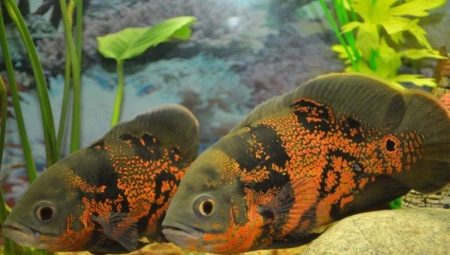
The aquarium is a small mysterious underwater world, admiring which you can escape from the daily hustle and bustle. However, many novice aquarists make one big mistake: they populate a tank without first asking about the compatibility of the selected inhabitants. Today we will consider cichlids and figure out which "neighbors" are suitable for them.
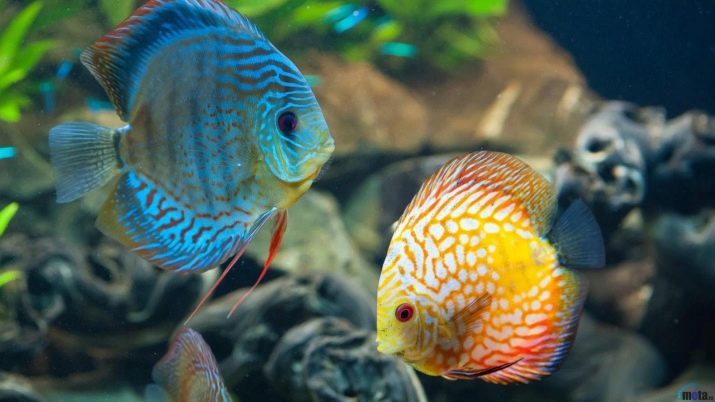
Who are they?
Cichlids (cichlids) are fish belonging to the ray-finned family, the perch-like order. According to various sources, the number of species ranges from 2000 to 3000. In nature, cichlids live in North, South and Central America, Africa (mainly lakes Tanganyika and Malawi), Asia and Madagascar. Cichlids are bright and unusual fish that attract many hobbyists not only for their unique appearance, but also for their behavior: they are wonderful caring parents.
But it is worth remembering that these are predators, aggressively disposed towards outside inhabitants of their territory, so it is very important to study the list of suitable "neighbors" and potential victims.
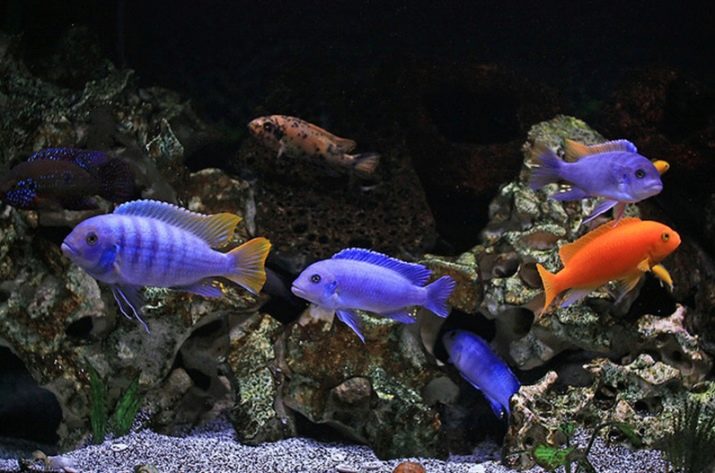
Content rules
To keep cichlids always healthy and energetic, The following tips from experienced aquarists should be followed with regards to their maintenance:
- the container where the cichlids will live must have a volume of at least 150 liters, and better - more than 200 liters;
- diffused light is desirable for illumination;
- it is definitely worth installing filters and a water aerator;
- every week it is supposed to clean the container and change the water in it;
- cichlids do not tolerate low water temperatures, so it should always be kept at + 28 ° C.
These fish are very fond of hiding and digging holes, so it is recommended to use coarse sand as a substrate and decorate the bottom with the help of artificially created grottoes, caves, stone slides.
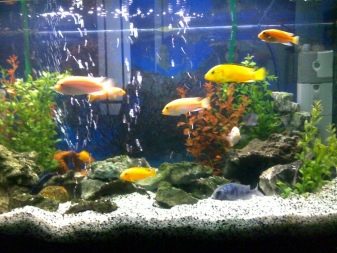

Compatible with other fish
It is worth considering the compatibility table of some popular cichlid species with other inhabitants of the aquarium world.
Variety | Aquarium plants | Compatibility with other fish |
Cichlazoma Meek | It is advisable to plant large plants with hard leaves: anubias, echinodorus. | They get along with akars, scalars. They are at enmity with Astronotus, as they are larger and more aggressive. |
Eight-striped cichlazoma (bee cichlazoma) | Echinodorus and Anubias. | Any small fish will become prey for them, therefore it is recommended to settle them with large ones: plexomus, black pacu, brocade pterygoplicht. |
Tsikhlazoma severum | It is recommended to plant plants with strong roots and hard leaves, as well as those that grow quickly - Vallisneria, Cryptocorynes. | Severum can get along with catfish, astronotuses. But the neighborhood with a small fish like a guppy, neon is fraught with death for the latter. |
Astronotus | These fish are very fond of spoiling green spaces. That is why it is recommended to put stones, heavy driftwood, clay shards in the aquarium to the astronotuses, but not to plant plants. For decorative purposes, you can use artificial ones. | They are tolerant of representatives of cichlids (if only those are not smaller in size). Any small, slow-swimming fish are eaten. |
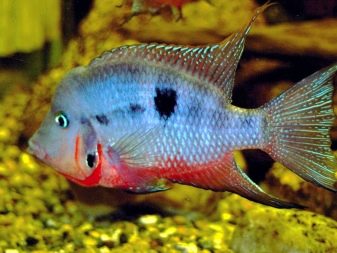
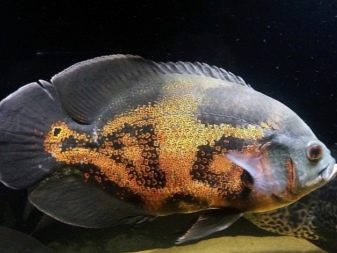
Variety | Aquarium plants | Compatibility with other fish |
Apistogram Ramirezi (butterfly cichlid) | It differs from its congeners in that it does not touch vegetation and does not dig into the ground. Therefore, you can plant water moss, fern, vallisneria, echinodorus and other plants. | Non-aggressive fish. It can calmly coexist with black mollies, guppies, swordtails, neons, rhodostomuses, and platies. Cannot be kept together with other cichlids, catfish, goldfish. |
Parrot | It is recommended to plant hornwort for water purification and filtration. It is advisable to strengthen the root system with pebbles so that the parrot cannot dig up the plant. | Tolerant to most fish similar in size. Recommended neighbors: Congo, swordtails, black mollies, Sumatran barbs. |
Chromis handsome | Perhaps the only plant recommended for planting is anubias. All the rest will be dug up and eaten away. | It is advisable to lodge handsome chromis with large fish that will not let themselves be offended. Bee cichlids, turquoise and bluish-spotted cichlids are suitable. But it is better not to lodge a scalar with them, since chromis like to bite off their fins. |
Scalaria | Large-leaved plants (amazon, nymphea) are recommended for planting - they are useful for scalars for laying eggs. | Scalarians are quite peaceful creatures, therefore they get along with many species of fish. They will not touch catfish, zebrafish, labeo, dwarf cichlid, petsilia. It is undesirable to lodge with neons, guppies, barbs, large cocky fish. |
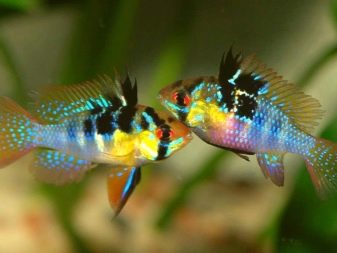
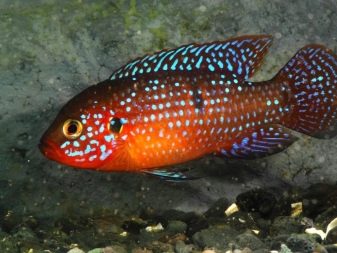
Variety | Aquarium plants | Compatibility with other fish |
Japanese Parrot (Theraps) | Therapies love to dig holes, so choose soft soil. Plant any of the plants recommended above, since the fish are indifferent to them. | Any small fish will be perceived by theraps as prey, so choose such “neighbors” as Meek's cichlazoma, scalars, bluish-spotted crayfish, Congo, barbs (Sumatran, Denisoni, bream), Mettinis. You should be careful with the flower horn - it can kill the therapist. |
Melanochromis Johan | The bottom of the aquarium should be laid out with fragments of stones, covered with coarse sand, and clay shards should be put there, creating artificial grottoes. Plants are not needed. | Tolerant to other varieties of cichlids.Get along with lemon cichlids, hummingbirds, pawnshops, ocellaris cichla. |
Auratus "Golden Parrot" | Only hard-leaved Anubias is recommended for planting, since other aquatic plants will be destroyed. | Auratus is an aggressor, especially male fish try. It is best to settle them either with those who can "give back", for example, with pseudotrophies, or with fast-swimming fish living in the upper sector of the aquarium. |
Princess Burundi | It does not need underwater flora, but it will be grateful to you for decorating the bottom with stones, sand soil, clay shards and snags. | A slightly aggressive variety of cichlids, it coexists well on the same territory with its congeners. However, you cannot settle them together with the Mbuna cichlid, since it is distinguished by aggression, and with orange lamprologus, since interspecific crossing is not excluded. |


Variety | Aquarium plants | Compatibility with other fish |
Blue dolphin | Recommendations are the same as for Melanochromis Johan and Princess of Burundi. | Any small fish will become a victim, equal-sized "neighbors" will live with the dolphin in peace and harmony. African catfish, frontosa are especially recommended. It is better not to settle the cichlida Mbuna, as she is too aggressive. |
Pseudotropheus Lombardo | They love to dig up plants and gnaw on foliage, so either plant anubias or give up the aquatic flora altogether. | A very vicious fish, ready to attack anyone who gets in its way. Male pseudotrophies cannot coexist peacefully in one container, so choose one male and several females for settling. |
Queen of Tanganyika (frontosa) | Anubias, echinodorus are recommended for planting. | They belong to non-aggressive varieties, but they guard the territory so zealously that it is advisable to keep only them. You can form a flock of one male and 3-4 females, or settle 9-12 fish at once. |
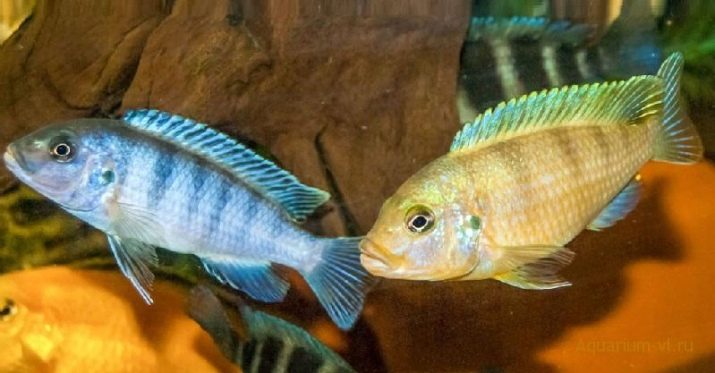
Important! Cichlids do not get along with the following species:
- cockerels;
- goldfish (crucian carp, as their progenitor, is also persona non grata);
- telescopes;
- guppy.
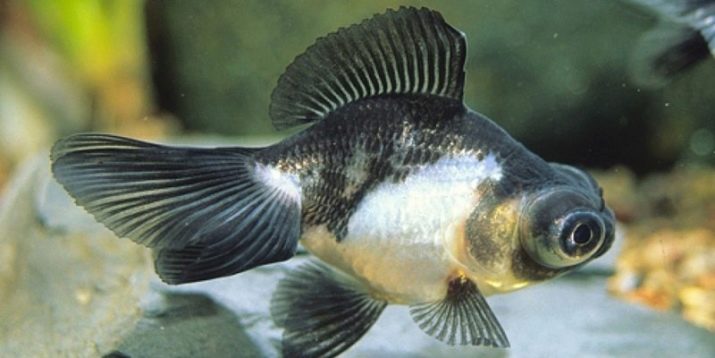
See the next video for cichlid compatibility.








